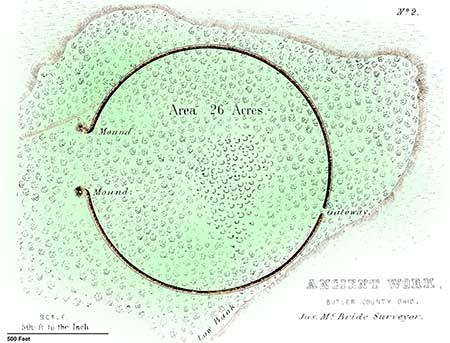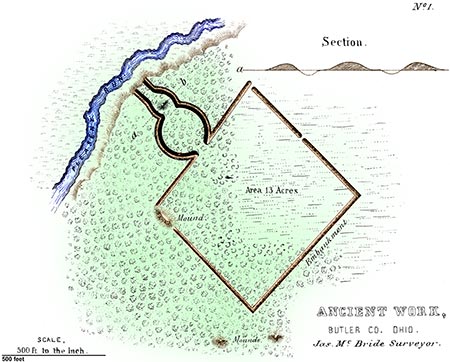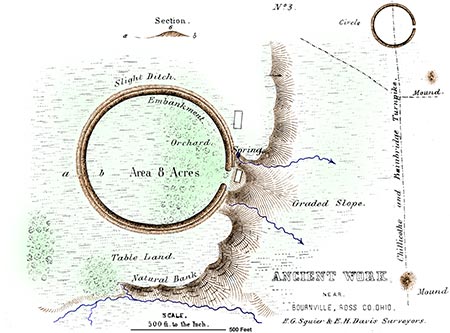PLATE XXX. No. 1.65
THIS work is situated four miles south-west of the town of Hamilton, Butler county, Ohio, on S. 10, T. 1, R. 2, between the Great and Little Miami rivers. It is indicated by the letter C, in the Map of a section of the Miami valley (Plate III, No. 2).
The ground upon which this unique work is built is the level bottom of the Miami river, at a distance from any high lands. The principal or square portion of the work is constructed of an embankment of earth, about four feet high by fifty feet base, unaccompanied by a ditch. The walls of the circular or irregular portion of the work, towards Pleasant run, are considerably heavier, and have an interior ditch. The work is not an exact square, nor are its gateways disposed with the. usual degree of regularity. The walls, at the western angle, terminate in a large oblong mound, and a small mound occupies the centre of one of the attached circular works.
At a short distance from the enclosure, towards the south, are two large mounds, placed one hundred and thirty-five feet apart. They are each about two hundred and fifty feet in circumference, and fifteen feet in perpendicular height, and are in part composed of large stones. These mounds, as also the larger portion of the enclosure, are situated in timbered land, the forests presenting the usual primitive aspect. The trees growing upon the walls are of the largest size, and are surrounded by the fallen and decayed trunks of their predecessors. From this work to the Miami river, the distance is now about half a mile; the intervening bottom is low and of comparatively recent formation. It is probable that the river once washed the work, at the point now bounded by Pleasant run.
For reasons which it is here unnecessary to recapitulate, this work is deemed
of religious origin.

PLATE XXX. No. 2.65
THIS work is indicated by the letter F, in the map of a section of the Miami valley, and is situated on the right bank of the Miami river, seven miles below the town of Hamilton, Butler county, Ohio, on S. 27 and 34, T. 3, R. 2, E. M.Little can be said respecting it, except that it is a circle of considerable size, bounded by an embankment, at present about two feet high, composed of earth taken up evenly from the surface, or brought from a distance. It has an entrance to the left, two hundred and seventy-five feet wide; the embankment upon either hand terminating in a small mound, between four and five feet high. The area of the enclosure is level, and covered with forest: the trees are, however, small, owing probably to the nature of the soil, which is thin and gravelly. The plain is here fifty feet above the adjacent bottoms.
About a mile north-east of this work, on the opposite bank of Indian creek, are three large mounds, on a line with each other. On the lower bottom or terrace, opposite to each mound, is a corresponding hole or excavation, from which the earth composing them was doubtless obtained.
PLATE XXX. No. 3.
Ancient Work Near Bournville, Ross County, Ohio.
THE small work here figured is one of the most beautiful in the State of Ohio. It is situated upon the highest terrace, directly facing, and about one mile distant from, the great stone hill-work of the Paint creek valley (Plate IV). It consists of a wall of earth, eight or ten feet in height, with a broad and shallow exterior ditch. In figure it is elliptical, with a transverse diameter of seven hundred and fifty, and a conjugate diameter of six hundred and seventy-five feet. It has a gateway one hundred and twenty feet wide, leading into it from the south-west. It opens upon a small spur of the terrace, which has been artificially rounded and graded, so as to make a regular and easy descent to the lower level. Upon either side of this grade, the banks of the terrace are steep and irregular. A very copious spring of water starts from the bank near the wall, a little to the right of the entrance. A small circle and a couple of mounds are situated on the next lower terrace, at the points indicated in the plan.
This work is admirably preserved, and is remarkable as being the only circular work at present known, which has its ditch exterior to the walls. The proprietor esteems the soil much richer within the enclosure, than upon the adjacent plain. We are unprepared to ascribe any other than a religious origin to this structure.
PLATE XXX. NO. 4.
Stone Work on "Black Run," Ross County, Ohio.
THIS unique work is situated in the little valley of "Black run," a small tributary of Paint creek, and is distant about fifteen miles from Chillicothe. It is indicated by the letter E, in the "Map exhibiting a section of six miles of the Paint creek valley." The walls are composed of stones; but if ever regularly laid up, they are now thrown down, though not greatly scattered. The outlines are clearly defined, and can be exactly traced. The body of the work is elliptical in shape, its conjugate diameter being one hundred and seventy feet, its transverse two hundred and fifty feet. There is a single opening or gateway, fifty feet wide, on the south, where the walls curve outwards and lap back upon themselves for the space of sixty feet. The most remarkable feature of this singular work consists of five walls, starting within ten feet of the unbroken line of the elliptical enclosure, and extending thence northward, slightly converging, for the distance of one hundred feet. The lines of the outer walls, if prolonged, would intersect each other at the distance of two hundred and fifty feet. These walls are twenty feet broad at the ends nearest the enclosure, and ten feet apart. They diminish gradually, as they recede, to ten feet at their outer extremities. The western wall is nearly obliterated; the stones for the construction of all the "cabin" hearths and chimneys in the neighborhood having been taken from this spot. The western portion of the wall of the ellipse has also suffered from the same cause. The amount of stone embraced in the outer walls is considerable, probably sufficient to construct walls of equal length, six feet broad and eight feet high. They now exhibit but slight evidence of ever having been regularly laid up, and more resemble mounds of stones rudely thrown together. The stones have been removed from a section of the central wall, to the base; but we have been unable to ascertain that the operation disclosed relics of any kind. The wall of the body of the work appears considerably lighter than those last mentioned, and it is now quite impossible to determine whether it was ever regularly constructed. The stones cover a space fifteen or twenty feet broad, and are irregularly heaped together to the height of perhaps three feet. The work is overgrown with briers, bushes, and trees; which, when in leaf, completely hide its features from view, and render a satisfactory examination impossible. In the autumn or spring, the entire outline of the work is distinctly visible.
The purposes of this strange work are entirely inexplicable: its small size precludes the idea of a defensive origin. It is the only structure of the kind which has yet been discovered in the valleys, and it is totally unlike those found on the hills. The great "Stone Fort" on Paint creek (Plate IV) is but two miles distant, and overlooks this work; both may be regarded as belonging to the same era, and as probably in some way connected with each other.
65. From the Survey and Notes of JAMES MCBRIDE, Esq.




